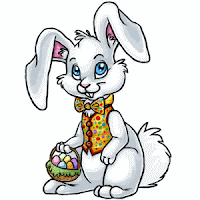The Story of the Easter Bunny--How the Easter bunny came to have his job is told with child-like wonder in The Story of the Easter Bunny by Katherine Tegen, illus. by Sally Anne Lambert. When a "round old couple" who diligently worked year after year painting eggs, weaving baskets and making chocolates can no longer do the work, their pet rabbit takes on the task himself. Muted watercolors of an endearingly antiquated town and the couple's cozy home add to the sweetness of the story. Copyright 2005 Reed Business Information.
The Easter Egg--Jan Brett's finely detailed watercolor and gouache art is a showstopper, spotlighting lifelike—though nattily clad—rabbits decorating eggs in hopes of winning the role of the Easter Rabbit's helper. Hoppi is awed by bunnies' creations, which include an ornate chocolate egg and a “whirling, twirling mechanical egg.” But when an egg tumbles out of a robin's nest, he keeps it safe until the baby bird hatches. Borders of twigs, pussy willows, daffodils, and ferns add greatly to the warm, visually sumptuous setting of this gentle spring story.
For traditional Hispanic people, Easter has a very Catholic origin, the death and resurrection of Jesus Christ. The concept of the Easter bunny and the Easter egg is not a part of that tradition. When I talked with Giovanni and Dominick about these two books they did have a little background knowledge about the Easter bunny and Easter eggs because they have been in the United States for a while and have actually participated in an Easter egg hunt at a friend's home for Easter.
Yet, they truly didn't feel as if they understood how the bunny and the egg have become part of a truly religious holiday for them. We read through each of the texts together and then talked about the stories behind these two traditions. I also pulled out information from the internet regarding the genesis of the Easter bunny and the Easter egg and how they have been integrated into the religious background of Easter here in the United States.
Being Catholic I think that I have a grasp of where Giovanni and Dominick are coming from in regards to Easter. As Morrow suggests, I feel that I understand the cultural aspects and diversity these two boys bring to their understanding of Easter. Hopefully while working through these two picture books I was able to extend their understanding of traditions that have become a part of America's celebration of Easter. To help solidify these two culturally oriented aspects of Easter we decided to make a double-bubble thinking map (have already used these in class) about Easter in America and Easter in Mexico. Using the texts and their background info about Easter in Mexico and Easter in America I was able to supplement information while they created their thinking map. They did an excellent job and created a thorough and colorful double-bubble map about Easter. Our ELL resource teacher is going to let them present their map to her one sixth grade which consists mainly of Hispanic ELL students.


No comments:
Post a Comment